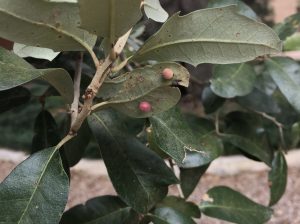During my first observation, I learnt that in some areas in Texas, “especially around lakes and bodies of water, ball moss infestations can be huge. In the Austin area, however, the air is dryer and even by water, the infestations are generally not as bad”. Ball moss on branches were present on The Sorin Live Oak and I found out that they are epiphytes (plant that growth on another plant) but are not parasite to the tree.
 Now in that blog I want to talk more about the changes that I could perceived over the past 2 months. First, I will talk about the leaves and we can see on the left picture that the leave is pretty green. On the other picture that has been taken recently, we can observe the change in color from a green to a yellow. The yellowing and scorched leaves often result in defoliation (dropping of leaves). At this season healthy trees still bear their leaves; the leaves will fall in April as new ones emerge. They will then replace their leaves over a short period of several weeks in the spring. New swollen leaf buds should be clearly visible when trees are dropping leaves. Occasionally, you may see new tiny leaflets starting to form as leaves drop off.
Now in that blog I want to talk more about the changes that I could perceived over the past 2 months. First, I will talk about the leaves and we can see on the left picture that the leave is pretty green. On the other picture that has been taken recently, we can observe the change in color from a green to a yellow. The yellowing and scorched leaves often result in defoliation (dropping of leaves). At this season healthy trees still bear their leaves; the leaves will fall in April as new ones emerge. They will then replace their leaves over a short period of several weeks in the spring. New swollen leaf buds should be clearly visible when trees are dropping leaves. Occasionally, you may see new tiny leaflets starting to form as leaves drop off.
In late September, acorns begin forming clusters at the tips of the branches, typically with three to five acorns on each cluster. Acorns are green at first, later turning a shiny, dark chestnut brown. Live oaks continue to produce acorns until December. Oaks generally prefer to grow in full sun so Austin is the perfect location for them. They are not usually picky about soil, and will grow in sand, loam or clay, in acidic or alkaline conditions, as long as soil is well-drained. Depending on species, they may prefer dry or wet conditions.
Galls are abnormal swellings of plant tissue induced by insects, bacteria, fungi, mites and nematodes. Insect-induced galls are the most common galls in urban areas. Among the insects causing galls are certain moth caterpillars, beetles, flies, aphids and small wasps. The gall growth provides residing insects with food and shelter during certain developmental stages. Galls have characteristic sizes, shapes and colors. In early days, when little was known about galls, naturalists named and described some galls according to plant growth patterns rather than by the insects causing them. This practice has changed because some insect species induce more than one type of gall (Gordon, 2003). When I first started observing the leaves on September, I never seen galls on them. On November 13, I first started seeing this change so since there is nothing to do with whether but other species, I feel pretty lucky to be able to see galls in a short period of time of observation.
In term of Wildlife site, I could see birds coming in and out and birds who were taking the moss located on the tree branches and I believe that they were constructing their nest. It was the first time that I was actually taking the time to really observe a bird construct his nest.
While searching for location of this trees I found out that Southern live oaks are confined to warm parts of the country, though, because of their inability to survive freezing temperatures. I was really surprised that this tree was located to that specific green area that we can see on the map. I thought that I will be more spread up since heat and humidity is about the same in New mexico, Arizona, Louisiana and Florida but it was not the case.
Also, in term of comparison with other Oaks, I found out that two types of Oaks like this one were hard to distinguish. Thanks to Conrad in the Naturalist newspaper, I came to the conclusion that this Oak should be a Quercus fusiformis and not a Quercus virginiana because it occupies central and southern Texas, and also by the form of the leaves and its colors (Conrad, 2012). In addition, it is smaller and hardier. Texas live oak, Quercus fusiformis, is typically found in Texas on dry sites, unlike Southern Live Oak, Quercus virginiana, which prefers wetter conditions.
Logan Buignet
References
- Gordon W. Frankie et al. (2003, February 2). The Mealy Oak Gall on Ornamental Live Oak in Texas. Retrieved November 15, 2017. URL:https://nueces.agrilife.org/files/2011/08/mealy-oak-gall.pdf
- Edward F. et al. (1994, October). Quercus virginiana, Southern Live Oak. Retrieved November 15, 2017. URL:http://hort.ufl.edu/database/documents/pdf/tree_fact_sheets/quevira.pdf
- Conrad, J. (2012, September 2). Texas live oak. Retrieved November 15, 2017. URL:http://www.backyardnature.net/n/w/tex-live.htm



